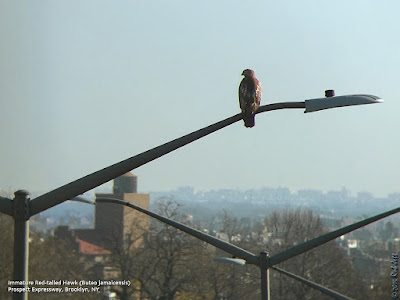Below is a list of upcoming nature trips by local birding/conservation groups for the weekend of Saturday, December 5, 2015 to Sunday, December 6, 2015:
Audubon Center in Prospect Park
Saturday, December 5, 2015, 12–1 pm
Introduction to Bird Watching
Look! Up in the sky, it’s a bird! But what kind of bird is it? Join the Prospect Park Alliance to learn about the magnificent array of birds that call Prospect Park home. Led by the Brooklyn Bird Club
Sunday, December 6, 10 am – 11 am
Early Morning Bird Walk: Twelve Birds of Winter
Not everyone flies south for the winter. Spot Prospect Park’s most common winter birds during their busiest time of day. Led by the Brooklyn Bird Club, this tour leaves promptly at 10 am.
**********
Brooklyn Bird Club
Sunday, December 6, 2015
Prospect Park
Leader: Dennis Hrehowsik
Focus: winter migrants, waterfowl, ducks, and raptors
No registration necessary. Meet at 8:00 am at the "Pergola ," Ocean and Parkside Avenues park entrance http://binged.it/1UiffD1 . Nearest train stop: "Q" local stop at Parkside Avenue; otherwise express "B" stops at Prospect Park, walk south along Ocean Avenue
**********
Huntington-Oyster Bay Audubon Society
Sunday, December 6, 2015 - 9:00 AM
Pelham Bay Park Bird Walk
Today we will look for resident and visiting owls, as well as waterfowl and late migrants.
Directions: Hutchinson River Parkway to the Pelham Bay Park/City Island/Orchard Beach exit. Continue east farther into the park past the traffic circle then veering left to the parking area on Hunter Island. Meet the group there.
Registration: 631-885-1881
**********
Linnaean Society of New York
Saturday, December 5, 2015
Rye Playland and Environs
Leader: Tom Burke
Registrar: Louise Fraza — louisefraza@yahoo.com or 212-534-6182
Registration opens: Monday November 23
Ride: $25
**********
New York Botanical Garden (Bronx)
Saturday, December 5, 2015
Debbie Becker leads a free bird walk at the Garden every Saturday from 11 a.m. to 12:30 p.m. beginning at the Reflecting Pool in the Leon Levy Visitor Center
**********
New York City Audubon Society
Sunday, December 6, 2015, 10am – 1pm
Central Park Winter Walk
Guide: Gabriel Willow
Meet at the entrance to Central Park at Central Park West and 72nd Street. Some of the best sightings await hardy nature-lovers willing to venture out in winter! Several species of owls can be seen in Central Park for example, but generally only in the colder months. "Winter finches" such as Pine Siskins, Redpolls, and Crossbills have also been found at the feeders or in conifers in the park. Observing the adaptations for cold-weather survival among Blue Jays, Titmice, and other resident species is fascinating as well. Warm up after the walk with a hot chocolate by the fireplace at the Loeb Boathouse. Limited to 15. $36 (25)
Click here to register
**********
Protectors of Pine Oak Woods (Staten Island)
Saturday, December 5, 2015, 1:00pm – 3:00pm
Old Mill Road
Contact: Clay Wollney 718-869-6327
Park at the end of Old Mill Road, behind the church. We will stroll along the multi-use trail next to Fresh Kills, below the hills of LaTourette Golf Course and return along the Blue Trail. From the remains of colonial structures to the Hessian Spring and the remains of Ketchum’s Mill we will take a look into the influence of man and nature on the ecosystems bordering the Fresh Kills estuary.
Saturday, December 5, 2015, 3:00pm – 5:00pm
Acme Pond
Contact: John Paul Learn 718-619-5051
Acme Pond is a diverse ecosystem, located on the north side of Hylan Boulevard across from Wolfe’s Pond Park. This walk will take us through hiking trails in some of the most idyllic woodlands in all of New York City. The trail offers views of the freshwater pond and assortment of small swampy areas. We will meet at the corner of Seguine Avenue and Herbert Street. Street parking is available on Herbert Street and in parking lots at the end of Herbert Street (http://goo.gl/maps/59dvC).
Sunday, December 6, 2015, 1:00pm – 3:00pm
Buck’s Hollow and/or Heyerdahl Hill
Contact: John Paul Learn 718-619-5051
Located in the Greenbelt, Heyerdahl Hill is nestled in an impressive stretch of woodland, holding ruins of a stone home built in the 1800s and plants and trees rarely seen in urban woodlands. We will meet at the stone wall on Meisner Avenue, located by the intersection of Rockland Avenue and Meisner Avenue (http://goo.gl/maps/YP1HI).
**********
Queens County Bird Club
Saturday, December 5, 2015, 7:30am – 6:00pm
Montauk Point
Leader: Rich Kelly (516) 509-1094
Be sure to CONTACT LEADER to confirm meeting time/place
**********
South Shore Audubon Society
Sunday, December 6, 2015
Jamaica Bay Wildlife Refuge
Notes:
All walks start at 9:00 A.M.
There is no walk if it rains or snows or temperature is below 25°F.
For more information or in case of questionable weather conditions, please phone Joe at 516 467-9498
For directions to our bird-watching locations, click here.
**********
Urban Park Rangers
Saturday, December 5, 2015
Introduction to Bird Watching at Audubon Center at the Boathouse (in Prospect Park), Brooklyn
12:00 p.m.–1:00 p.m.
Look! Up in the sky, it’s a bird! But what kind of bird is it? Join the Prospect Park Alliance to learn about the magnificent array of birds that call Prospect Park home.
Free!
Birding: Owls at Seaman Avenue and Isham Street Entrance (in Inwood Hill Park), Manhattan
5:00 p.m.–6:30 p.m.
As the leaves fall and temperatures drop, its a great time of year to spot owls which are migrating south, and might spend the winter in NYC Parks.
Free!
Sunday, December 6, 2015
Early Morning Bird Walk: Twelve Birds of Winter at Audubon Center at the Boathouse (in Prospect Park), Brooklyn
10:00 a.m.–11:00 a.m.
Not everyone flies south for the winter. Spot Prospect Park’s most common winter birds during their busiest time of day.
Free!
...Read more






























